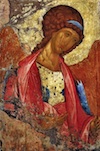 Archangel Michael Archangel Michael
The Holy Archangel Michael is one of the
most celebrated of the Angels and bodiless powers; he
is called the Archistrategos, or chief commander, of
all the bodiless powers. According to Holy Scripture
and Tradition, he has interceded for humanity multiple
times and continues to serve as the Defender of the
Faith The name Michael means "like unto God" or "Who
is like unto God?"
Michael first appears in the Old
Testament in the book of Joshua's account of the fall
of Jericho. Though Michael is not mentioned by name in
the text, it is said that Joshua "looked up and saw a
man standing in front of him with a drawn sword in his
hand." When the still unaware Joshua asks which side
of the fight the Archangel is on, Michael responds,
"neither...but as commander of the army of the Lord I
have now come" (Joshua 5:13-14).
In the book of Daniel, Michael appears
first to help the Archangel Gabriel defeat the
Persians (10:13). In a later vision it is revealed to
Daniel that "at that time [the end times] Michael, the
great prince who protects your people, will arise.
There will be a time of distress such as has not
happened from the beginning of nations until then..."
(Ch. 12)1. Michael thus plays an important role as the
protector of Israel and later of his chosen people,
the Church.
The Church Fathers also ascribe to
Michael the following events: During the Exodus of the
Israelite from Egypt he went before them in the form
of a pillar of cloud by day and a pillar of fire by
night; the power of the great Chief Commander of God
was manifest in the annihilation of the 185 thousand
soldiers of the Assyrian emperor Sennacherib (4/2
Kings 19:35); also in the smiting of the impious
leader Heliodorus (2 Macc. 3: 24-26); and in the
protection of the Three Holy Youths: Ananias, Azarias
and Misail, thrown into the fiery furnace for their
refusal to worship an idol (Dan 3:22-25). Through the
will of God, the Chief Commander Michael transported
the Prophet Habbakuk (December 2) from Judea to
Babylon, to give food to Daniel in the lions' den
(Dan. 14:33-37). The Archangel Michael disputed with
the devil over the body of the holy Prophet Moses
(Jude 1:9).
In New Testament times, the holy
Archangel Michael showed his power when he
miraculously saved a young man, cast into the sea by
robbers with a stone about his neck on the shores of
Mt Athos. This story is found in the Athonite
Paterikon, and in the Life of St Neophytus of
Docheiariou (November 9).
Perhaps his most famous miracle, though, is the
salvation of the church at Colossae. Here a number of
pagans tried to destroy this church by diverting the
flow of two rivers directly into its path. However,
the Archangel appeared amongst the waters, and,
carrying a cross, channeled the rivers underground so
that the ground the church stood on would not be
destroyed. The spring which came forth after this
event is said to have special healing powers.
Michael also has been associated with
healing in other cases, as well as his primary role as
leader of the Church Militant. He has been said to
appear to Emperor Constantine the Great (d. 337) at
Constantinople, to have intervened in assorted
battles, and appeared, sword in hand, over the
mausoleum of Hadrian, in apparent answer to the
prayers of Pope St. Gregory I the Great (r. 590-604)
that a plague in Rome should cease.
Russians in particular have a special veneration to
Michael, along with the Theotokos. According to OCA,
"Intercession for Russian cities by the Most Holy
Queen of Heaven always involved Her appearances with
the Heavenly Hosts, under the leadership of the
Archangel Michael. Grateful Rus acclaimed the Most
Pure Mother of God and the Archangel Michael in church
hymns. Many monasteries, cathedrals, court and
merchant churches are dedicated to the Chief Commander
Michael. In Rus there was not a city where there was
not a church or chapel dedicated to the Archangel
Michael."
The Holy Archangel Michael
Iconography
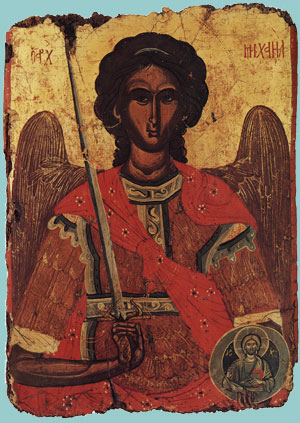 The
angelic hosts have to defend the creation against the
spiritual powers which seek to cast it into ruin. The
Apocalypse shows us the celestial war was, which
Michael and his angels fight against the dragon and
his angels (Rev 12:7-9), a war which continues on
earth in the spiritual combats in which men are
assisted by angels. Hence the warrior like character
that angelic apparitions often take. Thus, the
"captain of the Lord" appeared to Joshua with a sword
in his hand (Joshua 5:13-15). the Archangel Michael
"chief captain of the host" (Archistrategos) presides
over the struggle against the forces of the demons:
"there where thy grace appears, the power of the
demons is pursued; for the fallen Lucifer cannot bear
to see thy light. We pray thee then to extinguish his
burning features, directed against us... and to free
us from his temptations. The
angelic hosts have to defend the creation against the
spiritual powers which seek to cast it into ruin. The
Apocalypse shows us the celestial war was, which
Michael and his angels fight against the dragon and
his angels (Rev 12:7-9), a war which continues on
earth in the spiritual combats in which men are
assisted by angels. Hence the warrior like character
that angelic apparitions often take. Thus, the
"captain of the Lord" appeared to Joshua with a sword
in his hand (Joshua 5:13-15). the Archangel Michael
"chief captain of the host" (Archistrategos) presides
over the struggle against the forces of the demons:
"there where thy grace appears, the power of the
demons is pursued; for the fallen Lucifer cannot bear
to see thy light. We pray thee then to extinguish his
burning features, directed against us... and to free
us from his temptations.
The icon shown here (Balkan, ca. 1600) is of the
Archangel Michael. In his quality of Captain of the
Hosts, the warrior angel wears a cloak which, on our
icon , is red in color. The sword that he holds in his
right hand is at the same time his weapon and the
insignia of commander. In his left hand he carries
before his breast an image of Jesus Christ. The head
of the archangel is adorned with ribbons. Habitually,
the ends of he ribbons flow from either side of the
head: they should symbolize the spiritual hearing of
the angel, attentive to the divine commands. On our
icon these ribbons are partly effaced. The inscription
at the top reads: "Archangel Michael."
From Meaning of Icons by Lossky, Palmer, and
Kadloubousky
There are several icons of the Archangel
Michael that he has personally intervened miraculously
to the "authoring" of his image;
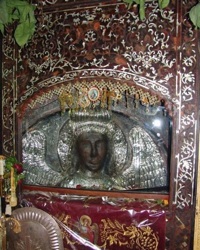 Mantamados
Icon Mantamados
Icon
Archangel Michael of Mantamados (Gr. O Μανταμάδος)
refers to a miraculous icon of the Archangel Michael
on the island of Lesvos. The monastery is known
locally as Taxiarches (the "Archangel"). There are two
accounts surrounding the date of this icon, one having
to do with the Ottoman Turkish occupation and
destruction of 1462, and the other with Saracen
pirates during the 9th and 10th centuries during which
the entire island was invaded. In either case, the
story of the creation of the icon shares the theme
that the target of the raids was the monastery of the
Taxiarchis. The pirates threatened the monks with
death if they would not reveal the whereabouts of the
hidden villagers. The monks refused and the invaders
slaughtered all of the monks except for one
novice-monk.
As the pirates where leaving, the novice climbed to
the roof of the monastery to be sure that the pirates
had left. However, the pirates noticed him from afar
and returned to kill him as well. It is at this point
in the story that the Archangel Michael makes his
appearance in front of the Saracens with his own sword
drawn forcing them to retreat in terror. Thanks to
this miracle from the Archangel the monk survived and
descending to the courtyard buried the bodies of his
fellow brotherhood. The monk still in deep respect and
reverence for having witnessed the Archangel Michael
in all his fury, gathered up the earth that was red by
the blood of the martyred monks and shaped it into the
icon-sculpture of the Archangel as it is today; while
it was still vivid in his memory. According to legend,
the monk did not have enough of this dirt-blood mix
and so the head of the Archangel has turned out
disproportionately larger to the rest of his body.
This icon, is now kept within the interior of the
church. Many islanders claim to have had personal
experiences of miracles being granted for them by
Mantamados.
This defies the traditional structure of iconography.
His upper-torso is represented as a three-dimensional
image mixed with dirt and blood of martyrs and he is a
warrior. His face is alive and he will mirror the
condition of your soul by the expression on his face.
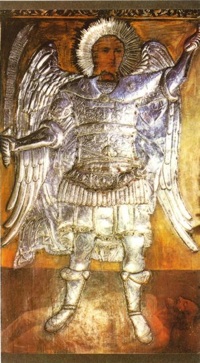 Panormitis
Icon Panormitis
Icon
Symi island of the Dodecanese, Greece, is situated in
southeast Aegean sea and northwest of Rhodes. While
touring around the island you will see many churches
and monasteries devoted to the Archangel Michael. The
Greek Orthodox Monastery of Taxiarchis Mihail
Panormitis is the most important on the island and
second largest in the Dodecanese. In the church is the
famous icon of the Archangel Michael Panormitis, who
is not only considered the island's patron saint but
also the guardian of sailors in the entire Dodecanese
area. One story is that this icon appeared
miraculously and, on several occasions, was removed
only to reappear mysteriously in this same location.
The church was then built over the location, which,
other sources suggest, was also a template to Apollo.
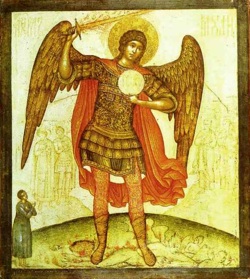 In
Russian iconography he is most likely to be wearing
red. In many instances, Michael tramples the devil
under his feet, which may be depicted as a dragon.
This comes from the tradition that Michael was the
main opponent of Satan in the battle for Heaven.
Satan, previously called Samael, was always looking to
discredit Israel, while Michael was its main
protector. In the end, Satan attempted to drag Michael
down in his fall from the heights, but Michael was
rescued by God. In
Russian iconography he is most likely to be wearing
red. In many instances, Michael tramples the devil
under his feet, which may be depicted as a dragon.
This comes from the tradition that Michael was the
main opponent of Satan in the battle for Heaven.
Satan, previously called Samael, was always looking to
discredit Israel, while Michael was its main
protector. In the end, Satan attempted to drag Michael
down in his fall from the heights, but Michael was
rescued by God.
Miracle
at Colossae or Chonae
Hymns
Troparion (Tone 4) [1]
Commanders of the heavenly hosts,
we who are unworthy beseech you,
by your prayers encompass us beneath the wings of your
immaterial glory,
and faithfully preserve us who fall down and cry to
you:
"Deliver us from all harm, for you are the commanders
of the powers on high!"
Kontakion (Tone 2) [2]
Commanders of God's armies and ministers of the divine
glory,
princes of the bodiless angels and guides of mankind,
ask for what is good for us, and for great mercy,
supreme commanders of the Bodiless Hosts.
|